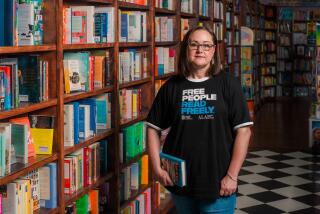On the Same Page
- Share via
Sitcoms poke fun at them. Publishers feed them discussion guides. Booksellers know them when they call--”We need 10 copies of ‘Angela’s Ashes,’ and can we get a discount?”
A group that frequents Martinez Books and Art Gallery in Santa Ana reads silently together and then discusses the book.
There’s one binding fact: Even a mediocre book can’t spoil an evening with book-group pals.
“I have a 3-year-old at home, so I love anything that involves not having to watch ‘Oliver’ again,” Lori Pear of Foothill Ranch says as her group relaxes over key lime pie and coffee. “It’s always a stimulating discussion and it’s interesting.”
Contagious too. It’s anyone’s guess how many at-home groups exist, but they leave a vapor trail as their numbers seem to soar.
The at-home groups are impossible to track, unlike bookstore, library and Internet groups, says Rachel W. Jacobsohn, author of “The Reading Group Handbook: Everything You Need to Know to Start Your Own Book Club” (Hyperion, 1994, $12).
They aren’t even new. Some venerable groups around the country have seen three generations come and go. But new ones are popping up all over, Jacobsohn says, and she thinks she knows why. Chat rooms are interesting. Bookstores can pull in authors and speakers. But the at-home group is family.
“It’s a family that you choose,” says Jacobsohn, who has been a professional reading group leader for 25 years and recently created an eight-hour workshop to meet the demand of people asking how they can get started.
“It’s a family that you voluntarily choose to associate with. It’s not a blood relation, or a cultural institution, like a church or job. . . . It really is this wonderful little organism floating around in our society, and the sociologists just can’t pin it down. It’s the damnedest cultural phenomenon because
nobody can statistically analyze where these groups are.”
Yes, Oprah Winfrey’s Book Club boosted the phenomenon. Yes, baby boomers’ sheer numbers can amplify anything they like, Jacobsohn says. But there’s more to it.
“It’s beneficial at the end of the 20th century for people to come face to face with each other in an emotionally, intellectually and spiritually stimulating atmosphere. It’s a form of continuing education. It’s a form of networking. It’s a form of self-validation.”
The trend is no big mystery to Danis Kreimeier, who’s in an at-home book group and recently started a mother-daughter book club at the Yorba Linda Public Library where she is supervisor of children’s services. Books, ideas and opinions are the focus of the discussions, but human contact is at the heart of it all.
“It’s not like you get together with your neighbor anymore over a cup of coffee. It’s a way of reconnecting,” Kreimeier says.
The grandmotherly types that comprise the 26-year-old Irvine Town and Gown Morning Book Group are tickled to see their old habit turn hip.
“Maybe people have grown up,” says Mabry Steinhaus of Irvine, one of the group’s original members.
Or maybe they’re discovering what Steinhaus and her fellow readers have long known: There’s no friend like a book friend. Companionship can be found over lunch or on the golf course, and that’s valuable, too. But read the same books with the same group of people and after a time you share a slice of common background, a set of reference points, jokes and even a kind of language.
When Steinhaus and fellow members of the group talked about their shared reading, their sentences fitted together like pieces of a puzzle. They chatted in a bookish brand of shorthand. The mention of one book sparked knowing nods and led to another and another and another.
“There’s a spirit of camaraderie that develops with the members,” says Mary Wood of Irvine. “You get to learn a lot about a person when you discuss a book with them.” That’s the best part, Kreimeier says.
“It’s almost like a slumber party mentality when you sit around and talk about really deep things because you’re not just analyzing it in an objective way. You’re bringing your self into it. Your experiences. Your way of relating it to your life,” she says. Young readers are smitten with the experience, too. It’s less threatening for preteens to discuss life issues when they can approach them vicariously through a book, she says.
“We have just as deep conversations with the mother-daughter group as we do in my adult group. We’ve tackled some really big issues--abandonment, peer pressure, bravery, finding a sense of self, identity,” Kreimeier says. “It’s a way for mothers to share their insights and beliefs too.”
But whether they’re an academic bunch reading little-known literature, or a group that rushes out for every Oprah’s Book Club selection, reading group fans say it comes down to this--it’s a joy to read, talk about reading, think about reading, eat while talking about reading and see what others are reading.
“It’s something that people are finding out is fun,” says Rueben Martinez, owner of Martinez Books and Art Gallery, where those silent readers sometimes show up before their discussions. “You discuss books. You discuss authors. You discuss life. And you only go through life once, so you might as well enjoy it.”
More to Read
Sign up for our Book Club newsletter
Get the latest news, events and more from the Los Angeles Times Book Club, and help us get L.A. reading and talking.
You may occasionally receive promotional content from the Los Angeles Times.










